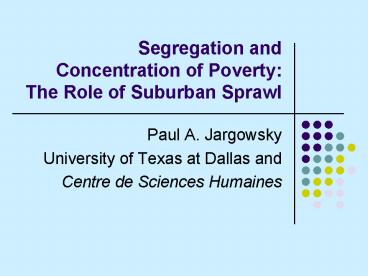Segregation and Concentration of Poverty: The Role of Suburban Sprawl - PowerPoint PPT Presentation
1 / 37
Title:
Segregation and Concentration of Poverty: The Role of Suburban Sprawl
Description:
The Role of Suburban Sprawl. Paul A. Jargowsky. University of Texas at Dallas and ... Rapid suburban development (or 'Sprawl') in the US undermines the Central Cities ... – PowerPoint PPT presentation
Number of Views:126
Avg rating:3.0/5.0
Title: Segregation and Concentration of Poverty: The Role of Suburban Sprawl
1
Segregation and Concentration of Poverty The
Role of Suburban Sprawl
- Paul A. Jargowsky
- University of Texas at Dallas and
- Centre de Sciences Humaines
2
Basic Argument
- Rapid suburban development (or Sprawl) in the
US undermines the Central Cities - The development pattern increases economic
segregation by concentrating the poor in the
inner cities - It also helps to maintain high levels of racial
segregation despite the elimination of de jure
controls on black residential location
3
Suburban Autonomy
- US Suburbs are independent political units
- Little or no external control on growth and
development - New suburbs in competition with each other, as
well as older suburbs and central city - Incentives favor rapid growth geared towards
low-density, automobile-dependent neighborhoods
serving high-income households, mostly white
4
Washington DC Metro Area
5
Washington DC Metropolitan Area Population by
State
6
Washington DC Metro Area, 1900-2000, Population
Change by County
Percent Change, 1900-1910
7
Washington DC Metro Area, 1900-2000, Population
Change by County
Percent Change, 1910-1920
8
Washington DC Metro Area, 1900-2000, Population
Change by County
Percent Change, 1920-1930
9
Washington DC Metro Area, 1900-2000, Population
Change by County
Percent Change, 1930-1940
10
Washington DC Metro Area, 1900-2000, Population
Change by County
Percent Change, 1940-1950
11
Washington DC Metro Area, 1900-2000, Population
Change by County
Percent Change, 1950-1960
12
Washington DC Metro Area, 1900-2000, Population
Change by County
Percent Change, 1960-1970
13
Washington DC Metro Area, 1900-2000, Population
Change by County
Percent Change, 1970-1980
14
Washington DC Metro Area, 1900-2000, Population
Change by County
Percent Change, 1980-1990
15
Washington DC Metro Area, 1900-2000, Population
Change by County
Percent Change, 1990-2000
16
Metropolitan Areas with Central City Population
Declines, 1990-2000
- Of the 100 Largest
- Metropolitan Areas
- 30 had central city declines (for example, those
to the left) - 51 more had central city growth less than
suburban growth
17
Suburban Growth Is Not Neutral
- Robert Park (1926) social distances are
translated to physical distances - In US, class is more uncertain, increasing
pressure to separate - Middle- and upper-income households have
relocated further and further towards the
periphery of urban space - Sharp contrast to the suburban development
patterns of many other nations, e.g. India, France
18
Percentage of Blacks and Poor Persons, 2000, in
Suburbs by Growth Rate, 1990-2000
Population Change (), Black and
1990-2000 Black Poor Poor Decline 22.4
14.2 6.1 0 to 25 12.1 11.9 2.8 25 to 50
8.5 9.7 1.5 50 to 100 9.9
7.8 1.3 100 or more 5.3 6.8 0.6 (Includes
all suburban places in metropolitan areas.)
19
Sprawls contribution to Concentration of Poverty
- Rich move to the newest suburbs
- Middle class moves to older suburbs
- Poor are left behind in low-density, declining
neighborhoods - The social and economic decay of these
neighborhoods frightens the middle class, and
creates a vicious cycle
20
Poverty Level Detroit Neighborhoods, 1970-2000
21
Poverty Level Detroit Neighborhoods, 1970-2000
22
Poverty Level Detroit Neighborhoods, 1970-2000
23
Poverty Level Detroit Neighborhoods, 1970-2000
24
Detroit the Bigger Picture
The large poverty area in 1970.
25
Detroit the Bigger Picture
and in 1990
26
Population Changes, 1970-1990 The MSA Hollows Out
27
The Process Continues, 1990-2000
28
Change in Poverty Rates, 1990-2000Detroit MSA
The central city did better, but the inner-ring
suburbs did not.
29
Dallas
1970-1990
1990-2000
Paul A. Jargowsky, University of Texas at
Dallas November 1, 2002
30
Cleveland
Change in Poverty Rates
1970-1990
1990-2000
31
St. Louis
Change in Poverty Rates
1970-1990
1990-2000
32
Modeling Sprawls Contribution to Racial
Segregation
- Identify all neighborhoods (census tracts) that
grew between 1990 and 2000 (net new housing
units) - Count all whites and blacks who moved into
growing tracts - Ask the question what if suburban development
had been racially neutral? - To be racially neutral, such growth would have to
be mixed income across broad areas.
33
Two Methods to Model Sprawls Effect on
Segregation
- Fixed proportion method assign 1990 movers to
growing census tracts in proportion to their
share of total movers into new housing. - Random moves method randomly assign white and
black movers to growing census tracts until all
new slots are filled.
34
Results for 10 Metropolitan Areas with Largest
Black Population
35
Implications
- Exclusivity racial and economic exclusion from
growth zones - Increases economic segregation
- Help to maintain high levels of racial
segregation - Lower density greater physical and social
distance between groups - Political fragmentation
- Balkanization of fiscal base
- Interacts with segregation to limit access to
high-quality education and other public amenities
36
Policy Directions
- Housing construction is highly regulated to
protect health and safety - Need to also regulate the growth process
- Pace of peripheral growth should be tied to
metropolitan growth rate, so it does not
undermine existing areas - Each suburban community must build a full range
of housing types - Public transportation needed to improve access to
geographically dispersed opportunities
37
Conclusion
- Housing construction is near permanent
- Once built, becomes the architecture of
segregation - Individual local decisions have significant
externalities - Regulation of suburban growth is needed to
- Break down racial and economic segregation
- Protect the long-term health of the community
- Promote the geographic access to public resources
necessary for equality of opportunity































